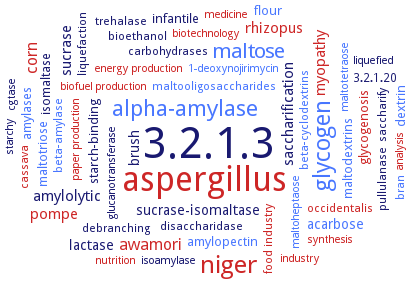3.2.1.3: glucan 1,4-alpha-glucosidase
This is an abbreviated version!
For detailed information about glucan 1,4-alpha-glucosidase, go to the full flat file.

Word Map on EC 3.2.1.3 
-
3.2.1.3
-
aspergillus
-
niger
-
glycogen
-
alpha-amylase
-
maltose
-
corn
-
awamori
-
amylolytic
-
pompe
-
sucrase
-
myopathy
-
saccharification
-
rhizopus
-
lactase
-
brush
-
sucrase-isomaltase
-
acarbose
-
dextrin
-
glycogenosis
-
maltotriose
-
amylopectin
-
flour
-
amylases
-
starch-binding
-
isomaltase
-
infantile
-
maltodextrins
-
occidentalis
-
bran
-
disaccharidase
-
food industry
-
pullulanase
-
liquefaction
-
beta-cyclodextrins
-
debranching
-
beta-amylase
-
carbohydrases
-
3.2.1.20
-
cassava
-
maltooligosaccharides
-
trehalase
-
saccharify
-
bioethanol
-
medicine
-
industry
-
energy production
-
paper production
-
glucanotransferase
-
nutrition
-
maltoheptaose
-
analysis
-
maltotetraose
-
biotechnology
-
cgtase
-
biofuel production
-
isoamylase
-
liquefied
-
1-deoxynojirimycin
-
starchy
-
synthesis
- 3.2.1.3
- aspergillus
- niger
- glycogen
- alpha-amylase
- maltose
- corn
- awamori
-
amylolytic
- pompe
- sucrase
- myopathy
-
saccharification
- rhizopus
- lactase
-
brush
- sucrase-isomaltase
- acarbose
- dextrin
- glycogenosis
- maltotriose
- amylopectin
- flour
- amylases
-
starch-binding
- isomaltase
-
infantile
- maltodextrins
- occidentalis
- bran
- disaccharidase
- food industry
- pullulanase
-
liquefaction
- beta-cyclodextrins
-
debranching
- beta-amylase
-
carbohydrases
-
3.2.1.20
- cassava
- maltooligosaccharides
- trehalase
-
saccharify
-
bioethanol
- medicine
- industry
- energy production
- paper production
-
glucanotransferase
- nutrition
- maltoheptaose
- analysis
- maltotetraose
- biotechnology
- cgtase
- biofuel production
- isoamylase
-
liquefied
- 1-deoxynojirimycin
-
starchy
- synthesis
Reaction
Synonyms
1,4-alpha-D-glucan glucohydrolase, 1,4-alpha-D-glucan-glucohydrolase, acid maltase, alpha-(1,4)-D-glucan glucohydrolase, alpha-1,4-D-glucan glucohydrolase, alpha-1,4-glucan glucohydrolase, AMG, AmyA, AmyC, AmyD, amyloglucosidase, AnGA, APGA1, AtriGA15A, exo-1,4-alpha-D-glucan glucanohydrolase, exo-1,4-alpha-D-glucanohydrolase, exo-1,4-alpha-glucosidase, exo-amylase, GA, GA A, GA1, GA2, GAI, GAII, GAM, GAM-1, GAM-2, gamma-amylase, GAMP, GHF15 glucoamylase, GLA, Gla1, GlaA, GLL1, Glu-1.1, Glu-A, Glu1, GlucaM, Glucan 1,4-alpha-glucosidase, glucoamylase, glucoamylase 1, glucoamylase 2, glucoamylase C, glucoamylase D, glucoamylase G1, glucoamylase GA15A, glucoamylase P, glucose amylase, GluR, glycoamylase, HjGA, HrGA, lysosomal alpha-glucosidase, maltase glucoamylase, maltase-glucoamylase, maltooligosaccharide-metabolizing enzyme, Meiotic expression upregulated protein 17, MGA, MGAM, More, PDE_05527, PoGA, PoGA15A, PoxGA15A, raw starch-degrading enzyme, raw starch-degrading glucoamylase, RSDE, RSDG, SBD, Sga1, SSG, Sta1, Sta1p, starch-digesting glucoamylase, TagA, tGA, TmGLA, TmGlu1, TtcGA


 results (
results ( results (
results ( top
top





